Optimization of Bioactive Compound Extraction from Eggplant Peel by Response Surface Methodology: Ultrasound-Assisted Solvent Qualitative and Quantitative Effect
Abstract
:1. Introduction
2. Materials and Method
2.1. Preparation of Samples for Extraction
2.2. Extraction Procedure and Yield
2.3. Total Monomeric Anthocyanin Pigment Determination
2.4. Total Phenolic Content (TPC)
2.5. Antioxidant Activity
2.5.1. DPPH Radical Scavenging Activity
2.5.2. Ferric Reducing Antioxidant Power (FRAP) Assay
2.6. Experimental Design and Statistical Analysis
3. Results and Discussion
3.1. Fitting the Response Surface Models for Total Phenol Content (TPC)
3.2. Fitting the Response Surface Models for Anthocyanin Content
3.3. Fitting the Response Surface Models for Extraction Yield
3.4. Fitting the Response Surface Models for Antioxidant Activity Based on DPPH Radical Scavenging Activity
3.5. Fitting the Response Surface Models for Antioxidant Activity Based on FRAP Assay
3.6. Optimization of the Solvent Formulation and Survey of Actual and Predicted Data
4. Conclusions
Author Contributions
Funding
Data Availability Statement
Acknowledgments
Conflicts of Interest
Ethical Statements
References
- Condurache (Lazar), N.N.; Croitoru, C.; Enachi, E.; Bahrim, G.E.; Stanciuc, N.; Rapeanu, G. Eggplant Peels as a Valuable Source of Anthocyanins: Extraction, Thermal Stability and Biological Activities. Plants 2021, 10, 577. [Google Scholar] [CrossRef] [PubMed]
- Gurbuz, N.; Uluisikb, S.; Frarya, A.; Fraryc, A.; Doganlara, S. Health benefits and bioactive compounds of eggplant. Food Chem. 2018, 268, 602–610. [Google Scholar] [CrossRef] [PubMed]
- Zhang, Y.; Sun, Y.; Zhang, H.; Mai, Q.; Zhang, B.; Li, H.; Deng, Z. The degradation rules of anthocyanins from eggplant peel and antioxidant capacity in a fortified model food system during the thermal treatments. Food Biosci. 2020, 38, e100701. [Google Scholar] [CrossRef]
- Hasbay, I.; Galanakis, C.M. Recovery technologies and encapsulation techniques. In Polyphenols: Properties, Recovery and Applications; Galanakis, C.M., Ed.; Woodhead Publishing: Cambridge, MA, USA, 2018; pp. 233–257. [Google Scholar]
- Sinela, A.M.; Mertz, C.; Achir, N.; Rawat, N.; Vidot, K.; Fulcrand, H.; Dornier, M. Exploration of reaction mechanisms of anthocyanin degradation in a roselle extract through kinetic studies on formulated model media. Food Chem. 2017, 235, 67–75. [Google Scholar] [CrossRef] [PubMed]
- Ferarsa, S.; Zhang, W.; Moulai-Mostefa, N.; Ding, L.; Jaffrin, M.Y.; Grimi, N. Recovery of anthocyanins and other phenolic compounds from purple eggplant peels and pulps using ultrasonic-assisted extraction. Food Bioprod. Process. 2018, 109, 19–28. [Google Scholar] [CrossRef]
- Barba, F.J.; Zhu, Z.; Koubaa, M.; Santana, A.S.; Orlien, V. Green alternative methods for the extraction of antioxidant bioactive compounds from winery wastes and by-products: A review. Trends Food Sci. Technol. 2016, 49, 96–109. [Google Scholar] [CrossRef]
- Saleh, I.A.; Vinatoru, M.; Mason, T.J.; Abdel-Azim, N.S.; Aboutabl, E.A.; Hammouda, F.M. A possible general mechanism for ultrasound-assisted extraction (UAE) suggested from the results of UAE of chlorogenic acid from Cynara scolymus L. (artichoke) leaves. Ultrason. Sonochem. 2016, 31, 330–336. [Google Scholar] [CrossRef]
- Dranca, F.; Oroian, M. Optimization of ultrasound-assisted extraction of total monomeric anthocyanin (TMA) and total phenolic content (TPC) from eggplant (Solanum melongena L.) peel. Ultrason. Sonochem. 2015, 31, 637–646. [Google Scholar] [CrossRef]
- Todaro, A.; Cimino, F.; Rapisarda, P.; Catalano, A.E.; Barbagallo, R.N.; Spagna, G. Recovery of anthocyanins from eggplant peel. Food Chem. 2009, 114, 434–439. [Google Scholar] [CrossRef]
- Lee, J.; Durst, R.W.; Wrolstad, R.E. Determination of total monomeric anthocyanin pigment content of fruit juices, beverages, natural colorants, and wines by the pH differential method: Collaborative study. J. AOAC Int. 2005, 88, 1269–1278. [Google Scholar] [CrossRef] [Green Version]
- Afkhami, R.; Goli, M.; Keramat, J. Functional orange juice enriched with encapsulated polyphenolic extract of lime waste and hesperidin. Int. J. Food Sci. 2018, 53, 634–643. [Google Scholar] [CrossRef]
- Brand-Williams, W.; Cuvelier, M.E.; Berset, C. Use of a free radical method to evaluate antioxidant activity. LWT-Food Sci. Technol. 1995, 28, 25–30. [Google Scholar] [CrossRef]
- Sun, Y.; Qin, Y.; Li, H.; Peng, H.; Chen, H.; Xie, H.; Deng, Z. Rapid characterization of chemical constituents in Radix Tetrastigma, a functional herbal mixture, before and after metabolism and their antioxidant/anti proliferative activities. J. Funct. Foods. 2015, 18, 300–318. [Google Scholar] [CrossRef]
- Jalalizand, F.; Goli, M. Optimization of microencapsulation of selenium with gum Arabian/Persian mixtures by solvent evaporation method using response surface methodology (RSM): Soybean oil fortification and oxidation indices. J. Food Meas. Charact. 2021, 15, 495–507. [Google Scholar] [CrossRef]
- Zaghian, N.; Goli, M. Optimization of the production conditions of primary (W1/O) and double (W1/O/W2) nano-emulsions containing vitamin B12 in skim milk using ultrasound wave by response surface methodology. J. Food Meas. Charact. 2020, 14, 3216–3226. [Google Scholar] [CrossRef]
- Maghamian, N.; Goli, M.; Najarian, A. Ultrasound-assisted preparation of double nano-emulsions loaded with glycyrrhizic acid in the internal aqueous phase and skim milk as the external aqueous phase. LWT-Food Sic. Technol. 2021, 141, 108–109. [Google Scholar] [CrossRef]
- Mirani, A.; Goli, M. Optimization of cupcake formulation by replacement of wheat flour with different levels of eggplant fiber using response surface methodology. Food Sci. Technol. 2021, 42. [Google Scholar] [CrossRef]
- Mirani, A.; Goli, M. Production of the eggplant-fiber incorporated cupcake and evaluating its chemical, textural and colorimetric properties over a ten-day storage time. J. Food Process. Preserv. 2021, 45, e15311. [Google Scholar] [CrossRef]
- Sazesh, B.; Goli, M. Quinoa as a wheat substitute to improve the textural properties and minimize the carcinogenic acrylamide content of the biscuit. Food Sci. Technol. 2020, 44, e14563. [Google Scholar] [CrossRef]
- Cacace, J.E.; Mazza, G. Optimization of extraction of anthocyanins from black currants with aqueous ethanol. J. Food Sci. 2003, 72, 240–248. [Google Scholar] [CrossRef]
- Naczk, M.; Shahidi, F. Extraction and analysis of phenolics in food. J. Chromatogr. A 2004, 1054, 95–111. [Google Scholar] [CrossRef]
- Naczk, M.; Shahidi, F. Phenolics in cereals, fruits and vegetables: Occurrence, extraction and analysis. J. Pharm. Biomed. Anal. 2006, 41, 1523–1542. [Google Scholar] [CrossRef] [PubMed]
- Chirinos, R.; Rogez, H.; Camposa, D.; Pedreschi, R.; Larondelle, Y. Optimization of extraction conditions of antioxidant phenolic compounds from mashua (Tropaeolum tuberosum Ruız & Pavon) tubers. Sep. Purif. Technol. 2007, 55, 217–225. [Google Scholar]
- Fatiha, B.; Khodir, M.; Farid, D.; Tiziri, R.; Karima, B.; Sonia, O.; Mohamed, C. Optimisation of solvent extraction of antioxidants (phenolic compounds) from Algerian mint (Mentha spicata L.). Phcog. Commn. 2012, 4, 72–86. [Google Scholar]
- Ukrainczyk, L.; Mcbride, M.B. Oxidation of phenolics in acidic aqueous suspensions of manganese oxides. Clays Clay Miner. 1992, 2, 157–166. [Google Scholar] [CrossRef]
- Hosseini, S.; Gharachorloo, M.; Ghiassi-Tarzi, B.; Ghavami, M. Evaluation of the organic acids ability for extraction of anthocyanins and phenolic compounds from different sources and their degradation kinetics during cold storage. Polish J. Food Nutr. Sci. 2016, 66, 261–270. [Google Scholar] [CrossRef]
- Das, A.B.; Goud, V.; Das, C. Extraction of phenolic compounds and anthocyanin from black and purple rice bran (Oryza sativa L.) using ultrasound: A comparative analysis and phytochemical profiling. Ind. Crops Prod. 2017, 95, 332–341. [Google Scholar] [CrossRef]
- Agustin, A.R.; Falka, S.; Ju, Y. Influence of extracting solvents on its antioxidant properties of bawang Dayak. Int. J. Chem. Petrochem. Technol. 2016, 2, 1–10. [Google Scholar]
- Gadioli Tarone, A.; Keven Silva, E.; Dias de Freitas Queiroz Barros, H.; Bau Betim Cazarin, C.; Roberto Marostica Junior, M. High-intensity ultrasound-assisted recovery of anthocyanins from jabuticaba by-products using green solvents: Effects of ultrasound intensity and solvent composition on the extraction of phenolic compounds. Food Res. Int. 2021, 140, 110048. [Google Scholar] [CrossRef]
- Moure, A.; Cruz, J.M.; Franco, D.; Dominguez, J.M.; Sineiro, J.; Dominguez, H.; Nunez, M.J.; Parajo, J.C. Natural antioxidants from residual sources. Food Chem. 2001, 72, 145–171. [Google Scholar] [CrossRef]
- Boulekbache-Makhlouf, L.; Medouni, L.; Medouni-Adrar, S.; Arkoub, L.; Madani, K. Effect of solvents extraction on phenolic content and antioxidant activity of the byproduct of eggplant. Ind. Crops Prod. 2013, 49, 668–674. [Google Scholar] [CrossRef]
- Alothman, M.; Bhat, R.; Karim, A. Antioxidant capacity and phenolic content of selected tropical fruits. Food Chem. 2009, 115, 785–788. [Google Scholar] [CrossRef]


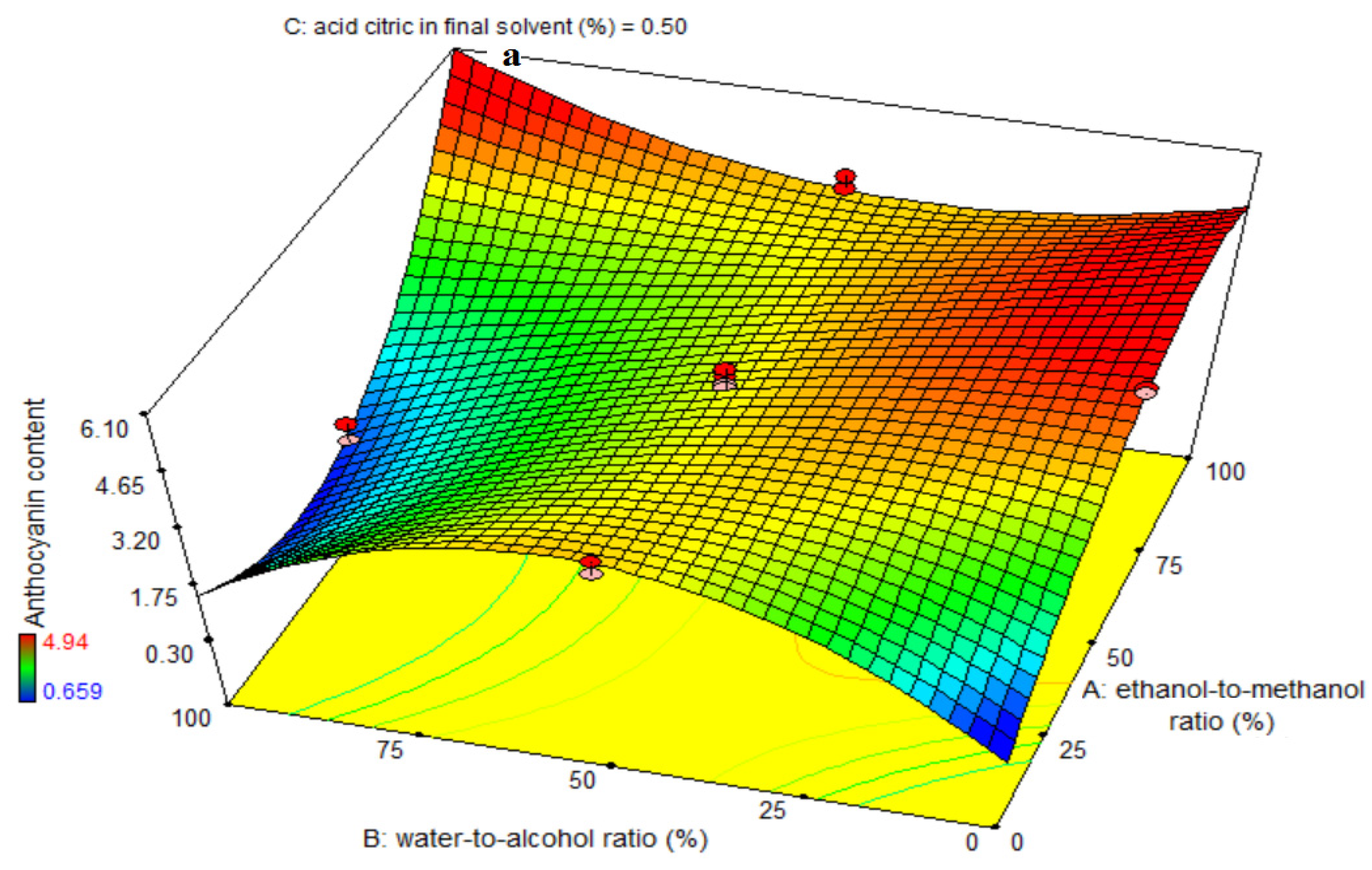
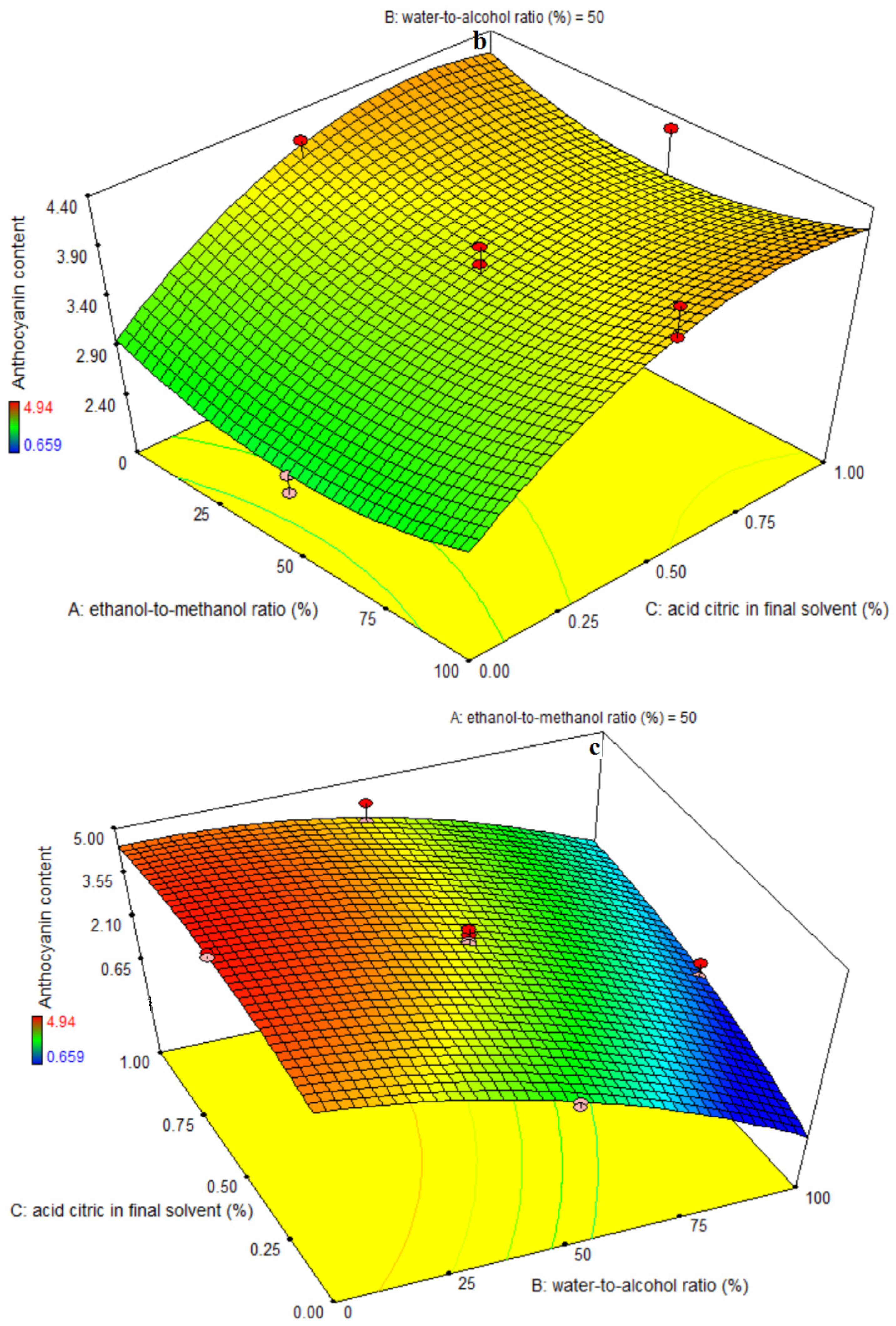
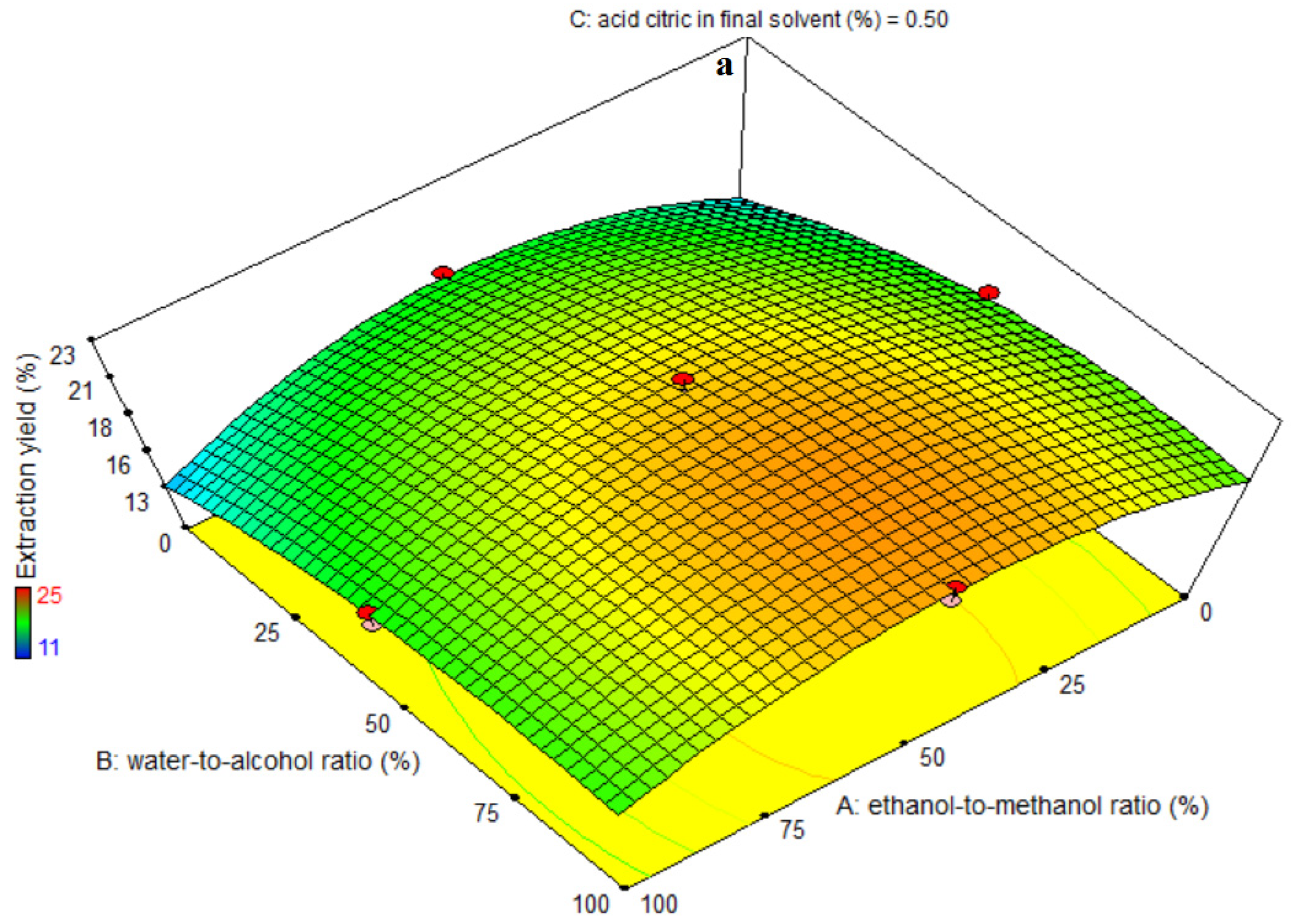
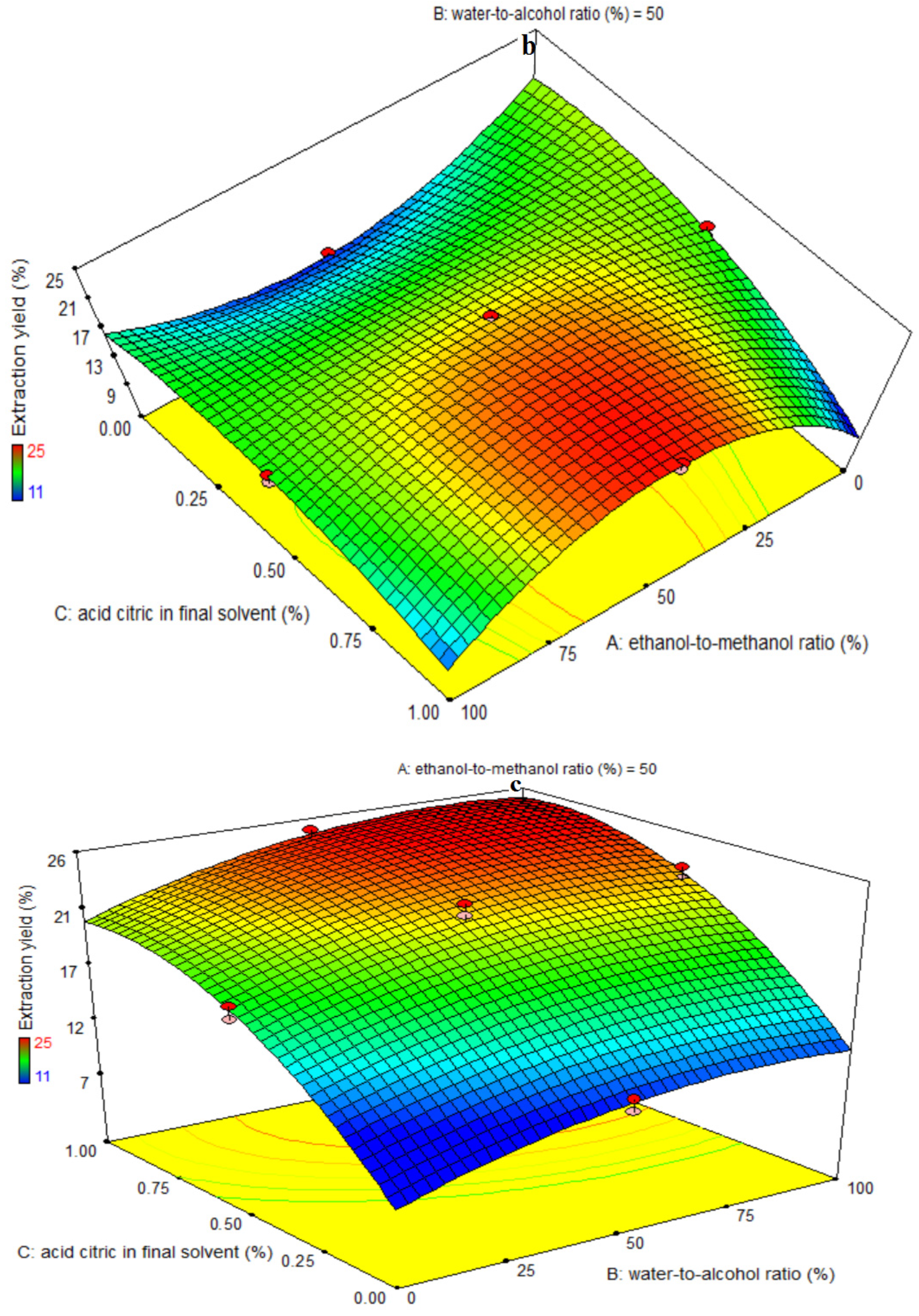
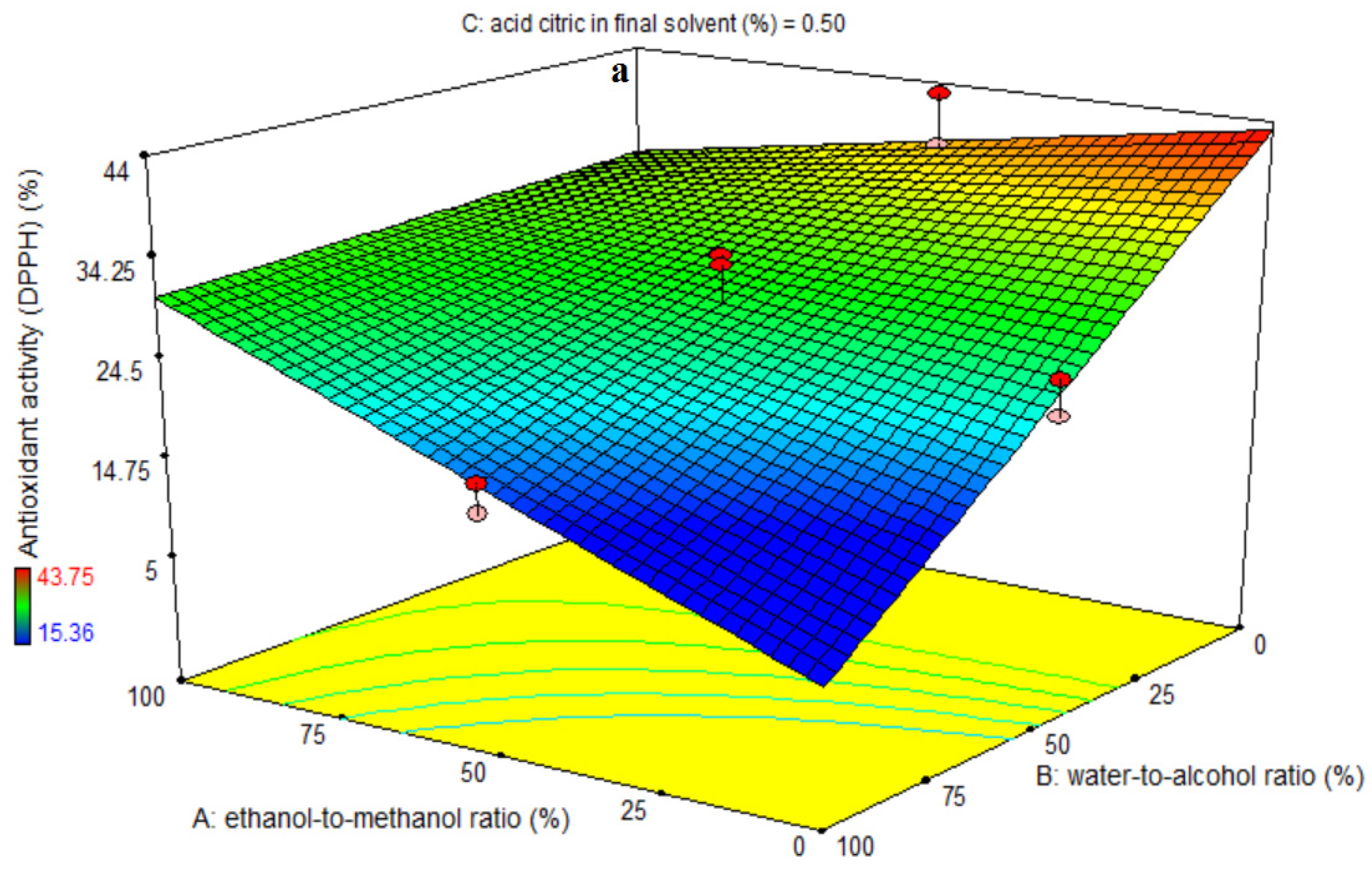


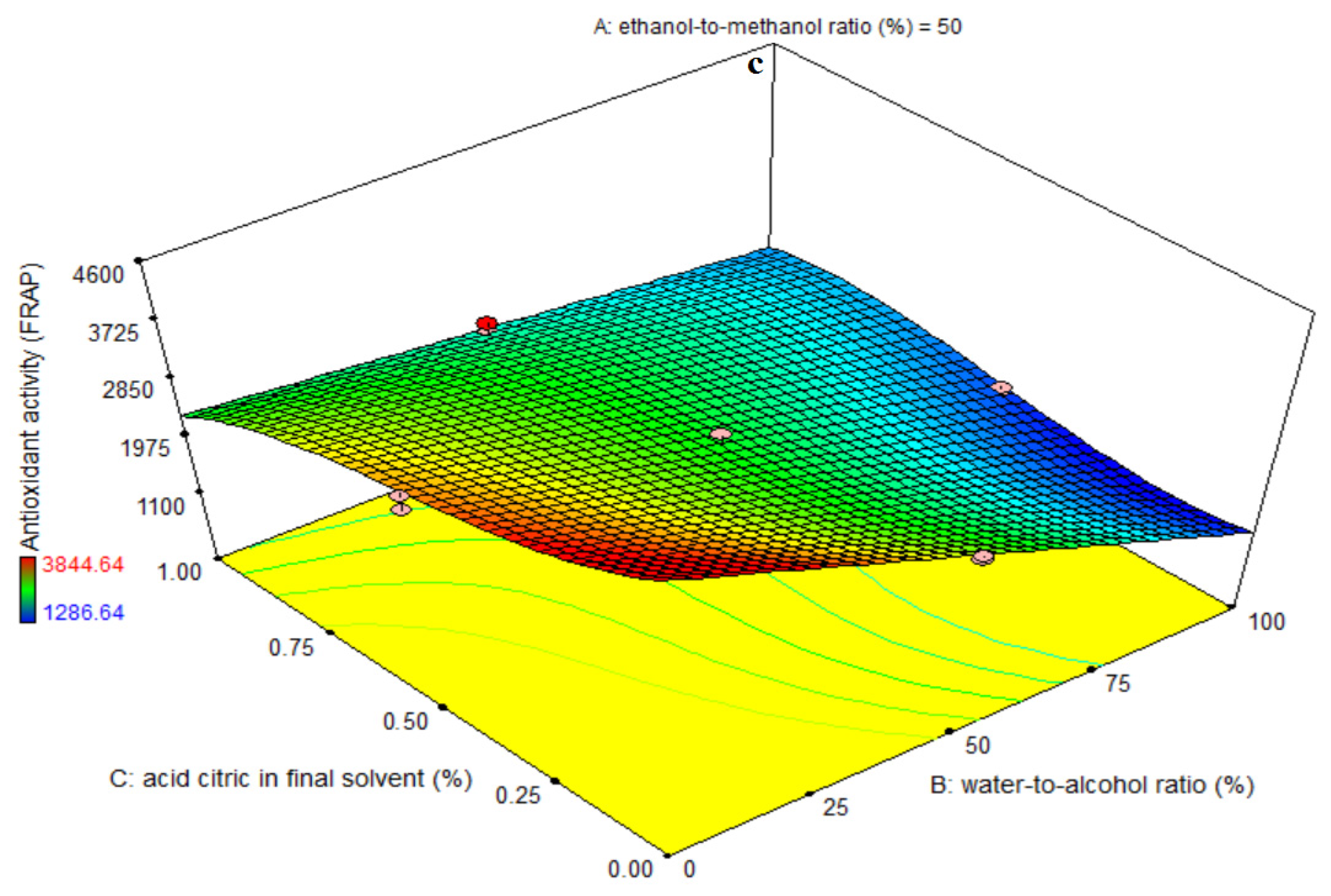
| Independent Variables | Code | Symbol | |||||||
|---|---|---|---|---|---|---|---|---|---|
| -α | −1 | 0 | +1 | +α | |||||
| Ethanol-to-methanol ratio (%) | A | 0 | 25 | 50 | 75 | 100 | |||
| Water-to-alcohol ratio (%) | B | 0 | 25 | 50 | 75 | 100 | |||
| Citric acid in final solvent (%) | C | 0 | 0.25 | 0.5 | 0.75 | 1 | |||
| Run | Ethanol-to- Methanol Ratio (%) | Water-to-Alcohol Ratio (%) | Citric acid in Final Solvent (%) | Total Phenol Content * | Anthocyanin Content ** | Extraction Yield (%) | Antioxidant Activity (%) *** (DPPH) | Antioxidant Activity (FRAP Assay) **** | |
| 1 | 0 | 50 | 0.5 | 115 | 3.79 | 19 | 22.26 | 1611 | |
| 2 | 0 | 50 | 0.5 | 129 | 4.11 | 18 | 25.78 | 1631 | |
| 3 | 25 | 75 | 0.75 | 92 | 3.09 | 23 | 17.96 | 1731 | |
| 4 | 25 | 75 | 0.75 | 111 | 2.49 | 23 | 22.65 | 1925 | |
| 5 | 25 | 75 | 0.25 | 93 | 1.96 | 20 | 17.96 | 2065 | |
| 6 | 25 | 25 | 0.75 | 119 | 3.96 | 21 | 25.91 | 2105 | |
| 7 | 25 | 25 | 0.75 | 125 | 4.1 | 20 | 25 | 2131 | |
| 8 | 25 | 75 | 0.25 | 106 | 2.17 | 19 | 19.53 | 2345 | |
| 9 | 25 | 25 | 0.25 | 155 | 3.75 | 18 | 33.98 | 2671 | |
| 10 | 25 | 25 | 0.25 | 163 | 3.92 | 17 | 43.75 | 3365 | |
| 11 | 50 | 100 | 0.5 | 98 | 1.13 | 23 | 18.22 | 1287 | |
| 12 | 50 | 100 | 0.5 | 83 | 0.66 | 22 | 15.36 | 1378 | |
| 13 | 50 | 50 | 1 | 119 | 4.26 | 25 | 23.17 | 1898 | |
| 14 | 50 | 50 | 0.5 | 123 | 3.53 | 22 | 31.77 | 1991 | |
| 15 | 50 | 50 | 1 | 116 | 3.67 | 24 | 27.34 | 2051 | |
| 16 | 50 | 50 | 0.5 | 133 | 3.8 | 22 | 26.17 | 2125 | |
| 17 | 50 | 50 | 0.5 | 133 | 3.97 | 21 | 25.52 | 2198 | |
| 18 | 50 | 50 | 0.5 | 143 | 3.59 | 23 | 32.81 | 2438 | |
| 19 | 50 | 50 | 0 | 151 | 2.61 | 12 | 32.68 | 2811 | |
| 20 | 50 | 50 | 0 | 151 | 2.41 | 11 | 30.2 | 2878 | |
| 21 | 50 | 0 | 0.5 | 164 | 4.94 | 18 | 37.63 | 3171 | |
| 22 | 50 | 0 | 0.5 | 170 | 4.81 | 17 | 42.96 | 3371 | |
| 23 | 75 | 75 | 0.25 | 100 | 2.49 | 19 | 26.43 | 1538 | |
| 24 | 75 | 75 | 0.25 | 114 | 3.06 | 18 | 28.77 | 1818 | |
| 25 | 75 | 75 | 0.75 | 117 | 3.62 | 23 | 29.16 | 2131 | |
| 26 | 75 | 75 | 0.75 | 111 | 3.46 | 24 | 28.38 | 2411 | |
| 27 | 75 | 25 | 0.75 | 145 | 4.36 | 20 | 30.2 | 3118 | |
| 28 | 75 | 25 | 0.25 | 156 | 4.28 | 17 | 36.2 | 3285 | |
| 29 | 75 | 25 | 0.75 | 137 | 4.54 | 21 | 27.6 | 3678 | |
| 30 | 75 | 25 | 0.25 | 157 | 4.16 | 16 | 34.24 | 3845 | |
| 31 | 100 | 50 | 0.5 | 120 | 4.37 | 18 | 29.29 | 2265 | |
| 32 | 100 | 50 | 0.5 | 137 | 4.08 | 17 | 30.99 | 2318 | |
| Total Phenol Content (mg Gallic Acid/g Dry Extract) | |||||||
|---|---|---|---|---|---|---|---|
| Source | Coefficient of Final Equation in Terms of Coded Factors | Sum of Squares | df | Mean Square | F Value | Prob > F | |
| Model | 127.76 | 14,768.55 | 4 | 3692.14 | 55.31 | <0.0001 | significant |
| A-ethanol-to-methanol ratio (%) | 2.99 | 285.95 | 1 | 285.95 | 4.28 | 0.0482 | |
| B-water-to-alcohol ratio (%) | −19.34 | 11,968.29 | 1 | 11,968.29 | 179.29 | <0.0001 | |
| C-citric acid in final solvent (%) | −7.01 | 1572.4 | 1 | 1572.4 | 23.55 | <0.0001 | |
| BC | 7.67 | 941.91 | 1 | 941.91 | 14.11 | 0.0008 | |
| Residual | - | 1802.4 | 27 | 66.76 | - | - | |
| Lack-of-Fit | - | 797.96 | 10 | 79.8 | 1.35 | 0.2816 | not significant |
| Pure Error | - | 1004.44 | 17 | 59.08 | - | - | |
| Cor Total | - | 16,570.95 | 31 | - | - | ||
| R2: 0.89, Adj-R2: 0.87, Pred-R2: 0.85, Adeq precision: 23.95, C.V.: 6.4% | |||||||
| Anthocyanin Content (mg Delphinidin-3-Glucoside/g Dry Extract) | |||||||
|---|---|---|---|---|---|---|---|
| Source | Coefficient of Final Equation in Terms of Coded Factors | Sum of Squares | df | Mean Square | F Value | Prob > F | |
| Model | 3.71 | 30.87 | 8 | 3.86 | 69.53 | <0.0001 | significant |
| B-water-to-alcohol ratio (%) | −0.99 | 15.83 | 1 | 15.83 | 285.17 | <0.0001 | |
| C-citric acid in final solvent (%) | 0.3 | 2.92 | 1 | 2.92 | 52.68 | <0.0001 | |
| BC | 0.13 | 0.29 | 1 | 0.29 | 5.18 | 0.0325 | |
| A2 | 0.09 | 0.26 | 1 | 0.26 | 4.71 | 0.0406 | |
| B2 | −0.21 | 1.41 | 1 | 1.41 | 25.32 | <0.0001 | |
| C2 | −0.12 | 0.47 | 1 | 0.47 | 8.47 | 0.0079 | |
| A2B | 0.32 | 0.84 | 1 | 0.84 | 15.08 | 0.0008 | |
| AB2 | 0.28 | 1.28 | 1 | 1.28 | 23 | <0.0001 | |
| Residual | - | 1.28 | 23 | 0.056 | - | - | |
| Lack-of-Fit | - | 0.31 | 6 | 0.052 | 0.91 | 0.5083 | not significant |
| Pure Error | - | 0.97 | 17 | 0.057 | - | - | |
| Cor Total | - | 32.15 | 31 | - | - | ||
| R2: 0.96, Adj-R2: 0.95, Pred-R2: 0.92, Adeq precision: 31.84, C.V.: 6.79% | |||||||
| Extraction Yield (%) | |||||||
|---|---|---|---|---|---|---|---|
| Model | 22.22 | 323.69 | 8 | 40.46 | 86.32 | <0.0001 | significant |
| A-ethanol-to-methanol ratio (%) | −0.22 | 1.53 | 1 | 1.53 | 3.27 | 0.0838 | |
| B-water-to-alcohol ratio (%) | 1.22 | 47.53 | 1 | 47.53 | 101.4 | <0.0001 | |
| C-citric acid in final solvent (%) | 3.25 | 169 | 1 | 169 | 360.53 | <0.0001 | |
| AC | 0.31 | 1.56 | 1 | 1.56 | 3.33 | 0.0809 | |
| A2 | −1 | 32 | 1 | 32 | 68.27 | <0.0001 | |
| B2 | −0.5 | 8 | 1 | 8 | 17.07 | 0.0004 | |
| C2 | −1 | 32 | 1 | 32 | 68.27 | <0.0001 | |
| A2C | −1.31 | 13.78 | 1 | 13.78 | 29.4 | <0.0001 | |
| Residual | - | 10.78 | 23 | 0.47 | - | - | |
| Lack-of-Fit | - | 2.28 | 6 | 0.38 | 0.76 | 0.6105 | not significant |
| Pure Error | - | 8.5 | 17 | 0.5 | - | - | |
| Cor Total | - | 334.47 | 31 | - | - | - | |
| R2: 0.97, Adj-R2: 0.96, Pred-R2: 0.94, Adeq precision: 35.80, C.V.: 3.47% | |||||||
| Antioxidant Activity in Terms of DPPH Radical Scavenging Activity (%) | |||||||
|---|---|---|---|---|---|---|---|
| Source | Coefficient of Final Equation in Terms of Coded Factors | Sum of Squares | df | Mean Square | F Value | Prob > F | |
| Model | 28.12 | 1219.03 | 5 | 243.81 | 29.74 | <0.0001 | significant |
| A-ethanol-to-methanol ratio (%) | 1.83 | 107.75 | 1 | 107.75 | 13.14 | 0.0012 | |
| B-water-to-alcohol ratio (%) | −5 | 800.6 | 1 | 800.6 | 97.64 | <0.0001 | |
| C-citric acid in final solvent (%) | −1.84 | 107.82 | 1 | 107.82 | 13.15 | 0.0012 | |
| AB | 2.19 | 76.74 | 1 | 76.74 | 9.36 | 0.0051 | |
| BC | 2.81 | 126.11 | 1 | 126.11 | 15.38 | 0.0006 | |
| Residual | - | 213.18 | 26 | 8.2 | - | - | |
| Lack-of-Fit | - | 64.47 | 9 | 7.16 | 0.82 | 0.6071 | not significant |
| Pure Error | - | 148.71 | 17 | 8.75 | - | - | |
| Cor Total | - | 1432.21 | 31 | - | - | ||
| R2: 0.85, Adj-R2: 0.82, Pred-R2: 0.77, Adeq precision: 16.14, C.V.: 10.18% | |||||||
| Antioxidant Activity in Terms of FRAP Assay (µM Fe+2/g Dry Extract) | |||||||
|---|---|---|---|---|---|---|---|
| Source | Coefficient of Final Equation in Terms of Coded Factors | Sum of Squares | df | Mean Square | F Value | Prob > F | |
| Model | 2447.88 | 1.25 × 107 | 7 | 1.78 × 106 | 24.91 | <0.0001 | significant |
| A-ethanol-to-methanol ratio (%) | 192.71 | 1.19 × 106 | 1 | 1.19 × 106 | 16.61 | 0.0004 | |
| B-water-to-alcohol ratio (%) | −499.67 | 7.99 × 106 | 1 | 7.99 × 106 | 111.65 | <0.0001 | |
| AB | −238.75 | 9.12 × 105 | 1 | 9.12 × 105 | 12.74 | 0.0015 | |
| AC | 212.92 | 7.25 × 105 | 1 | 7.25 × 105 | 10.14 | 0.004 | |
| BC | 160.41 | 4.12 × 105 | 1 | 4.12 × 105 | 5.75 | 0.0246 | |
| A2 | −85.88 | 3.54 × 105 | 1 | 3.54 × 105 | 4.95 | 0.0358 | |
| C3 | −57.43 | 8.97 × 105 | 1 | 8.97 × 105 | 12.53 | 0.0017 | |
| Residual | - | 1.72 × 106 | 24 | 71,559.64 | - | - | |
| Lack of Fit | - | 8.82 × 105 | 7 | 1.26 × 105 | 2.56 | 0.0535 | not significant |
| Pure Error | - | 8.36 × 105 | 17 | 49,156.45 | - | - | |
| Cor Total | - | 1.42 × 107 | 31 | - | - | - | |
| R2: 0.88, Adj-R2: 0.84, Pred-R2: 0.79, Adeq precision: 14.94, C.V.: 11.34% | |||||||
| Name | Upper | Lower | Upper | |||
|---|---|---|---|---|---|---|
| Goal | Limit | Limit | Weight | Weight | Importance | |
| A-ethanol-to-methanol ratio (%) | is in range | 0 | 100 | 1 | 1 | 3 |
| B-water-to-alcohol ratio (%) | is in range | 0 | 100 | 1 | 1 | 3 |
| C-citric acid in final solvent (%) | is in range | 0 | 1 | 1 | 1 | 3 |
| Total phenol content * | maximize | 83.47 | 170.366 | 1 | 1 | 3 |
| Anthocyanin content ** | maximize | 0.659 | 4.94 | 1 | 1 | 3 |
| Extraction yield (%) | maximize | 11 | 25 | 1 | 1 | 3 |
| Antioxidant activity (DPPH) *** (%) | maximize | 15.36 | 43.75 | 1 | 1 | 3 |
| Antioxidant activity (FRAP) **** | maximize | 1286.64 | 3844.64 | 1 | 1 | 3 |
| Optimal formulas for final solvent | ||||||
| 1- Ethanol-to-methanol ratio (59%) and water-to-alcohol ratio (0%), and citric acid in final solvent (0.47%) with desirability 0.95 | ||||||
| Parameters | Predicted | Actual | Δ (%) | |||
| Total phenol content * | 170.37 | 165.05 | 3.12 | |||
| Anthocyanin content ** | 5.2 | 5.08 | 2.31 | |||
| Extraction yield (%) | 17.14 | 16.63 | 2.98 | |||
| Antioxidant activity (DPPH) *** (%) | 38.11 | 37.06 | 2.76 | |||
| Antioxidant activity (FRAP) **** | 3716.92 | 3675.13 | 1.12 | |||
| 2- Ethanol-to-methanol ratio (67%) and water-to-alcohol ratio (0%), and citric acid in final solvent (0.56%) with desirability 0.82 | ||||||
| Parameters | Predicted | Actual | Δ (%) | |||
| Total phenol content * | 163 | 161.07 | 1.18 | |||
| Anthocyanin content ** | 5.4 | 5.17 | 4.26 | |||
| Extraction yield (%) | 17.83 | 16.99 | 4.71 | |||
| Antioxidant activity (DPPH) *** (%) | 34.64 | 33.35 | 3.72 | |||
| Antioxidant activity (FRAP) **** | 3802.79 | 3696.86 | 2.79 | |||
Publisher’s Note: MDPI stays neutral with regard to jurisdictional claims in published maps and institutional affiliations. |
© 2022 by the authors. Licensee MDPI, Basel, Switzerland. This article is an open access article distributed under the terms and conditions of the Creative Commons Attribution (CC BY) license (https://creativecommons.org/licenses/by/4.0/).
Share and Cite
Shahabi Mohammadabadi, S.; Goli, M.; Naji Tabasi, S. Optimization of Bioactive Compound Extraction from Eggplant Peel by Response Surface Methodology: Ultrasound-Assisted Solvent Qualitative and Quantitative Effect. Foods 2022, 11, 3263. https://doi.org/10.3390/foods11203263
Shahabi Mohammadabadi S, Goli M, Naji Tabasi S. Optimization of Bioactive Compound Extraction from Eggplant Peel by Response Surface Methodology: Ultrasound-Assisted Solvent Qualitative and Quantitative Effect. Foods. 2022; 11(20):3263. https://doi.org/10.3390/foods11203263
Chicago/Turabian StyleShahabi Mohammadabadi, Shiva, Mohammad Goli, and Sara Naji Tabasi. 2022. "Optimization of Bioactive Compound Extraction from Eggplant Peel by Response Surface Methodology: Ultrasound-Assisted Solvent Qualitative and Quantitative Effect" Foods 11, no. 20: 3263. https://doi.org/10.3390/foods11203263
APA StyleShahabi Mohammadabadi, S., Goli, M., & Naji Tabasi, S. (2022). Optimization of Bioactive Compound Extraction from Eggplant Peel by Response Surface Methodology: Ultrasound-Assisted Solvent Qualitative and Quantitative Effect. Foods, 11(20), 3263. https://doi.org/10.3390/foods11203263






